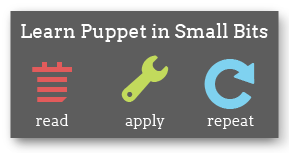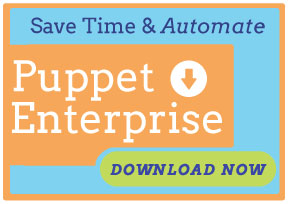This is the documentation for Puppet, the industry-leading configuration management toolkit. Most of the content here applies equally to Puppet Enterprise and open source releases of Puppet.
Drive-Thru
Small documents for getting help fast.
- Core Types Cheat Sheet — A double-sided reference to the most common resource types. (HTML version)
- Module Cheat Sheet — A one-page reference to Puppet module layout, covering classes and defined types, files, templates, and plugins. (HTML version)
- Frequently Asked Questions
- Glossary
Learning Puppet
Learn to use Puppet! New users: start here.
Part one: Serverless Puppet
- Resources and the RAL — Learn about the fundamental building blocks of system configuration.
- Manifests — Start controlling your system by writing actual Puppet code.
- Ordering — Learn about dependencies and refresh events, manage the relationships between resources, and discover the fundamental Puppet design pattern.
- Variables, Conditionals, and Facts — Make your manifests versatile by reading system information.
- Modules and Classes (Part One) — Start building your manifests into self-contained modules.
- Templates — Use ERB to make your config files as flexible as your Puppet manifests.
- Parameterized Classes (Modules, Part Two) — Learn how to pass parameters to classes and make your modules more adaptable.
- Defined Types — Model repeatable chunks of configuration by grouping basic resources into super-resources.
Part two: Master/Agent Puppet
- Preparing an Agent VM — Prepare your tools for the next few chapters with our step-by-step walkthrough.
- Basic Agent/Master Puppet — Tour the agent/master workflow: sign an agent node’s certificate, pick which classes a node will get, and pull and apply a catalog.
- More coming soon!
Reference Shelf
Puppet 3 Reference Manual
A concise reference to Puppet 3’s usage and internals. Use the left sidebar of any reference manual page to navigate between pages.
Puppet 2.7 Reference Manual
A concise reference to Puppet 2.7’s usage and internals. Use the left sidebar of any reference manual page to navigate between pages.
- Table of Contents
- Language — A complete reference to the Puppet language.
- Modules
Miscellaneous References
- REST API — reference of API-accessible resources
- Puppet Language Guide — an older version of the Puppet reference manual’s language reference
- Puppet Manpages — detailed help for each Puppet application
Generated References
Complete and up-to-date references for Puppet’s resource types, functions, metaparameters, configuration options, indirection termini, and reports, served piping hot directly from the source code.
- Resource Types — all default types
- Functions — all built in functions
- Metaparameters — all type-independent resource attributes
- Configuration — all configuration file settings
- Report — all available report handlers
These references are automatically generated from the inline documentation in Puppet’s source code. References generated from each version of Puppet are archived here:
- Versioned References — inline reference docs from Puppet’s past and present
Puppet Guides
Learn about different areas of Puppet, fix problems, and design solutions.
Components
Learn more about major working parts of the Puppet system.
- Puppet commands: master, agent, apply, resource, and more — components of the system
Installing and Configuring
Get Puppet up and running at your site.
- An Introduction to Puppet
- Supported Platforms
- Installing Puppet — from packages, source, or gems
- Configuring Puppet — use
puppet.confto configure Puppet’s behavior - Setting Up Puppet — includes server setup & testing
Basic Features and Use
- Puppet Language Guide — all the language details
- Module Fundamentals — nearly all Puppet code should be in modules.
- Installing Modules from the Puppet Forge — save time by using pre-existing modules
- Techniques — common design patterns, tips, and tricks
- Troubleshooting — avoid common problems and confusions
- Parameterized Classes — use parameterized classes to write more effective, versatile, and encapsulated code
- Module Smoke Testing — write and run basic smoke tests for your modules
- Scope and Puppet — understand and banish dynamic lookup warnings with Puppet 2.7
- Puppet File Serving — serving files with Puppet
- Style Guide — Puppet community conventions
- Best Practices — use Puppet effectively
Puppet on Windows
Manage Windows nodes side by side with your *nix infrastructure, with Puppet 2.7 and higher (including Puppet Enterprise ≥ 2.5).
- Overview
- Installing Puppet on Windows
- Running Puppet on Windows
- Writing Manifests for Windows
- Troubleshooting Puppet on Windows
- Developers Only: Running Puppet from Source on Windows
Tuning and Scaling
Puppet’s default configuration is meant for prototyping and designing a site. Once you’re ready for production deployment, learn how to adjust Puppet for peak performance.
- Scaling Puppet — general tips & tricks
- Using Multiple Puppet Masters — a guide to deployments with multiple Puppet masters
- Scaling With Passenger — for Puppet 0.24.6 and later
- Scaling With Mongrel — for older versions of Puppet
Advanced Features
Go beyond basic manifests.
- Templating — template out config files using ERB
- Virtual Resources
- Exported Resources — share data between hosts
- Environments — separate dev, stage, & production
- Reporting — learn what your nodes are up to
- Getting Started With Cloud Provisioner — create and bootstrap new nodes with the experimental cloud provisioner extension
- Publishing Modules on the Puppet Forge — preparing your best modules to go public
Hacking and Extending
Build your own tools and workflows on top of Puppet.
Using the Puppet Data Library
- Puppet Data Library: Overview — Puppet automatically gathers reams of data about your infrastructure. Learn where that data is, how to access it, and how to mine it for knowledge.
- Inventory Service — use Puppet’s inventory of nodes at your site in your own custom applications
Using APIs and Interfaces
- REST Access Control — secure API access with
auth.conf - External Nodes — specify what your machines do using external data sources
Using Ruby Plugins
- Plugins In Modules — where to put plugins, how to sync to clients
- Writing Custom Facts
- Writing Custom Functions
- Writing Custom Types & Providers
- Complete Resource Example — more information on custom types & providers
- Provider Development — more about providers
Developing Puppet
- Running Puppet from Source — preview the leading edge
- Development Life Cycle — learn how to contribute code
- Puppet Internals — understand how Puppet works internally



